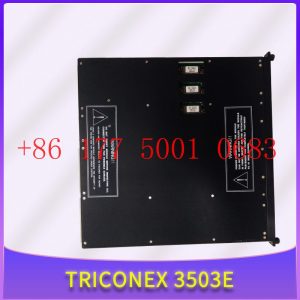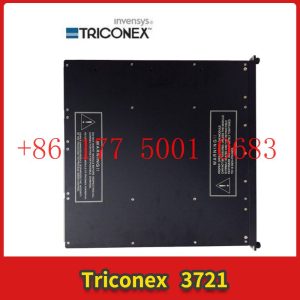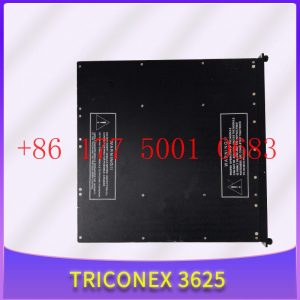Description
3805H Safety Instrumented System (SIS)
3805H Safety Instrumented System (SIS)
Module Clips Drive controller servo motor
Contact: Mr. Lai
Wechat:17750010683
Whats app:+86 17750010683
Skype:+86 17750010683
QQ: 3221366881
3221366881@qq.com
How to Build High Channel Density Digital IO Modules for the Next Generation Industrial Automation Controllers
With the rapid development of industrial automation, digital IO modules have become an indispensable part of industrial automation controllers. The digital IO module can connect the controller with external devices, such as sensors, actuators, etc., to achieve monitoring and control of industrial production processes. However, with the continuous development of industrial automation, digital IO modules need to have higher channel density and stronger functionality to meet the needs of new industrial automation controllers. Therefore, it is very important to build high channel density digital IO modules for the next generation of industrial automation controllers.
The digital IO module is one of the most fundamental modules in industrial automation controllers, and its main function is to connect the controller with external devices to achieve signal input and output. The digital IO module usually includes two parts: a digital input module and a digital output module. The digital input module can convert the digital signals of external devices into signals that the controller can read, while the digital output module can convert the digital signals output by the controller into signals that external devices can read. The channel density of a digital IO module refers to the number of digital input or digital output channels provided on the module, which is the input and output capacity of the module.
With the development of industrial automation, digital IO modules need to have higher channel density and stronger functions to meet the needs of new industrial automation controllers. The following are several aspects to consider when building a high channel density digital IO module for the next generation of industrial automation controllers:3805H Safety Instrumented System (SIS)
1. Choose the appropriate communication protocol
Digital IO modules typically communicate with controllers through communication protocols, so choosing a suitable communication protocol is crucial. Common communication protocols include Modbus, Profibus, CANopen, Ethernet, etc. Different communication protocols have different advantages and disadvantages, and selecting a suitable communication protocol requires considering the following factors:
(1) Communication speed: The faster the communication speed, the shorter the response time of the digital IO module, which can process input and output signals faster.
(2) Communication distance: The farther the communication distance, the wider the application range of digital IO modules.
(3) Reliability: The reliability of communication protocols determines the stability and reliability of digital IO modules.
(4) Cost: Different communication protocols have different costs, and suitable communication protocols need to be selected based on actual needs.
2. Choose the appropriate digital IO chip
The digital IO chip is the core component of the digital IO module, and its performance and function directly affect the channel density and function of the digital IO module. Choosing a suitable digital IO chip requires considering the following factors:
(1) Channel density: The channel density of digital IO chips determines the channel density of digital IO modules, and channel density needs to be selected based on actual needs.
(2) Input/output type: Digital IO chips usually support digital input and digital output, and some chips also support functions such as analog input and output, counters, etc.
(3) Speed: The speed of the digital IO chip determines the response speed of the digital IO module, and it is necessary to choose a chip with a faster speed.
(4) Accuracy: The accuracy of digital IO chips determines the signal accuracy of digital IO modules, and it is necessary to choose chips with higher accuracy.
(5) Cost: Different digital IO chips have different costs, and suitable chips need to be selected based on actual needs.
3. Optimize circuit design
The circuit design of digital IO modules has a significant impact on their performance and stability. In order to improve the channel density and functionality of digital IO modules, it is necessary to optimize circuit design, such as:
(1) Using high-speed digital IO chips: Using high-speed digital IO chips can improve the response speed and accuracy of the module.
(2) Adopting anti-interference design: In order to improve the stability of the digital IO module, it is necessary to adopt anti-interference design, such as using filters, isolators, etc.
(3) Using optimized PCB layout: Optimizing PCB layout can reduce noise and interference in digital IO modules, improve module performance and stability.
4. Choose the appropriate shell material and size
Digital IO modules typically need to be installed in cabinets or control cabinets, so choosing the appropriate housing material and size is crucial. The shell material should have good protective and heat dissipation properties to protect the circuits of the digital IO module from external environmental influences. The shell size should be able to adapt to different installation environments, such as cabinets, control cabinets, etc.
5. Optimize software design
The software design of the digital IO module determines its functionality and performance. In order to achieve high channel density and stronger functionality, it is necessary to optimize software design, such as:
(1) Supporting multiple input and output types: Supporting multiple input and output types can meet different application needs, such as digital input and output, analog input and output, counters, etc.
(2) Supporting multiple communication protocols: Supporting multiple communication protocols can adapt to different controllers and application environments.
(3) Support for online debugging and monitoring: Supporting online debugging and monitoring can facilitate user diagnosis and maintenance of modules.
(4) Support for expansion function: Supporting expansion function can increase the functionality and application range of the module while ensuring channel density.
In summary, building a high channel density digital IO module for the next generation of industrial automation controllers requires multiple considerations, including selecting suitable communication protocols, selecting suitable digital IO chips, optimizing circuit design, selecting suitable shell materials and sizes, and optimizing software design. Only by comprehensively considering these factors can a digital IO module with high channel density and stronger functionality be constructed to meet the needs of new industrial automation controllers.
How to assign IO devices to IO controllers?
PROFINET IO system
The PROFINET IO system consists of a PROFINET IO controller and its assigned PROFINET IO devices. After adding IO controllers and IO devices, it is necessary to assign IO controllers to the IO devices to form a basic PROFINET IO system.
Prerequisite requirements
● Already in the network view of STEP 7.
A CPU has been placed (e.g. CPU 1516-3 PN/DP).
● An IO device has been placed (e.g. IM 155-6 PN ST)
Operating Steps (Method 1)
To assign IO devices to IO controllers, follow these steps:
1. Move the mouse pointer over the interface of the IO device.
2. Hold down the left mouse button.
3. Drag the mouse pointer.
The pointer will now use the networking symbol to indicate the “networking” mode. At the same time, you can see a lock character appearing on the pointer
Number. The lock symbol only disappears when the pointer moves to a valid target position.
4. Now, move the pointer to the interface of the desired IO controller and release the left mouse button.
5. Now assign the IO device to the IO controller.
Operating Steps (Method 2)
To assign IO devices to IO controllers, follow these steps:
1. Move the mouse pointer over the word “Unassigned” in the bottom left corner of the IO device icon.
2. Click the left mouse button.
3. Select the IO controller interface to be connected from the available interfaces that appear.
4. Now assign the IO device to the IO controller.
What is the function of an IO chip
Io generally refers to input and output devices, where I is the input and O is the output. The input to the IO port of the chip is the external signal transmission to the chip, while the output is the internal signal transmission to other devices. The input and output are relative. In short, in a broad sense, the control of input and output interfaces is called an IO chip, and network cards are also considered IO or array cards.
The CPU must read and write data to external registers or ROMs on RAM or other hardware through IO commands (such as input/output commands). For example, reading a keyboard involves accessing external registers on the keyboard through the 60H port, and the chip on the keyboard scans the keyboard. Pressing or holding down a key for a long time will cause the chip to generate corresponding scan or break codes, which will be written to the external register of the 60H port, so that the CPU can achieve the purpose of controlling the keyboard. Therefore, I think IO chips should refer to a large category. The CPU already has powerful IO instructions and corresponding control buses.
51 microcontroller IO port input and output mode_ Four usage methods for IO ports
The traditional 51 microcontroller IO interface can only be used as a standard bidirectional IO interface. If it is used to drive LED, it can only be driven by injecting current or using a transistor external expansion drive circuit.
Current injection method: LED positive pole connected to VCC, negative pole connected to IO port. If the IO is at a high level, the two poles of the LED are at the same level, and there is no current, the LED will turn off; IO is at low power level, current flows from VCC to IO, and LED lights up. But when you connect the positive pole of the LED to the IO interface and the negative pole to GND, placing the IO interface at a high level will cause the LED to light up. However, due to the insufficient pull-up capability of the IO interface, the brightness is not ideal. The following method can be used to solve this problem.
Push-pull working mode: The positive and negative poles of the LED are connected to two IO ports, and then the positive IO interface is set as the push-pull output, while the negative IO interface is set as the standard bidirectional current input. The push pull method has strong pull-up ability and can achieve high-level LED driving.
Four usage methods for IO ports3805H Safety Instrumented System (SIS)
From the perspective of the characteristics of the I/O port, the P0 port of Standard 51 is an open drain structure when used as an I/O port, and in practical applications, a pull-up resistor is usually added; P1, P2, and P3 are all quasi bidirectional I/Os with internal pull-up resistors, which can be used as both input and output. The I/O port characteristics of the LPC900 series microcontroller have certain differences, and they can be configured into four different working modes: quasi bidirectional I/O, push pull output, high resistance input, and open drain.
Compared with Standard 51, the quasi bidirectional I/O mode differs in internal structure but is similar in usage. For example, when used as an input, it must first write “1” to set it to high level before reading the level state of the pin.!!!!! Why is it like this? Please refer to the diagram below for analysis.
The characteristic of push-3805H Safety Instrumented System (SIS)pull output is that it can drive a large current regardless of whether it outputs high or low levels. For example, when outputting high levels, it can directly light up the LED (by connecting several hundred ohm current limiting resistors in series), which is difficult to achieve in quasi bidirectional I/O mode.
The characteristic of high impedance input mode is that it can only be used as an input, but it can obtain relatively high input impedance, which is necessary in analog comparator and ADC applications.
The open drain mode is similar to the quasi bidirectional mode, but there is no internal pull-up resistance. The advantage of open drain mode is good electrical compatibility. If the external pull-up resistor is connected to a 3V power supply, it can interface with a 3V logic device. If the pull-up resistor is connected to a 5V power supply, it can also interface with a 5V logic device. In addition, the open drain mode can also conveniently implement the “line and” logic function.
For the explanation of the above question, there is this information:
High resistance state is a common term in digital circuits, referring to an output state of a circuit that is neither high nor low. If the high resistance state is input into the next level circuit, it has no impact on the lower level circuit, just like not connected. If measured with a multimeter, it may be high or low, depending on what is connected afterwards.
High resistance states can be understood as open circuits during circuit analysis. You can think of it as having a very high output (input) resistance. His limit can be considered suspended.
Typical applications of high resistance states:
1. On the bus connected structure. There are multiple devices hanging on the bus, and the devices are connected to the bus in a high impedance form. This automatically releases the bus when the device does not occupy it, making it easier for other devices to gain access to the bus.
2. Most microcontroller I/O can be set to high impedance input when used, such as Lingyang, AVR, and so on. High resistance input can be considered as having infinite input resistance, indicating that I/O has minimal impact on the preceding stage and does not generate current (without attenuation), and to some extent, it also increases the chip”s resistance to voltage surges.
1.Has been engaged in industrial control industry for a long time, with a large number of inventories.
2.Industry leading, price advantage, quality assurance
3.Diversified models and products, and all kinds of rare and discontinued products
4.15 days free replacement for quality problems
ABB — AC 800M controller, Bailey, PM866 controller, IGCT silicon controlled 5SHY 3BHB01 3BHE00 3HNA00 DSQC series
BENTLY — 3500 system/proximitor, front and rear card, sensor, probe, cable 3500/20 3500/61 3500/05-01-02-00-001 3500/40M 176449-01 3500/22M 138607-01
Emerson — modbus card, power panel, controller, power supply, base, power module, switch 1C31,5X00, CE400, A6500-UM, SE3008,1B300,1X00,
EPRO — PR6423 PR6424 PR6425 PR6426 PR9376 PR9268 Data acquisition module, probe, speed sensor, vibration sensor
FOXBORO — FCP270 FCP280 FCM10EF FBM207 P0914TD CP40B FBI10E FBM02 FBM202 FBM207B P0400HE Thermal resistance input/output module, power module, communication module, cable, controller, switch
GE —- IS200/215/220/230/420 DS200/215 IC693/695/697/698 VMICPCI VMIVME 369-HI-R-M-0-0-E 469 module, air switch, I/O module, display, CPU module, power module, converter, CPU board, Ethernet module, integrated protection device, power module, gas turbine card
HIMA — F3 AIO 8/4 01 F3231 F8627X Z7116 F8621A 984862160 F3236 F6217 F7553 DI module, processor module, AI card, pulse encoder
Honeywell — Secure digital output card, program module, analog input card, CPU module, FIM card
MOOG — D136-001-007 Servo valve, controller, module
NI — SCXI-1100 PCI – PXIE – PCIE – SBRIO – CFP-AO-210 USB-6525 Information Acquisition Card, PXI Module, Card
Westinghouse — RTD thermal resistance input module, AI/AO/DI/DO module, power module, control module, base module
Woodward — 9907-164 5466-258 8200-1300 9907-149 9907-838 EASYGEN-3500-5/P2 8440-2145 Regulator, module, controller, governor
YOKOGAWA – Servo module, control cabinet node unit
Main products:
PLC, DCS, CPU module, communication module, input/output module (AI/AO/DI/DO), power module, silicon controlled module, terminal module, PXI module, servo drive, servo motor, industrial display screen, industrial keyboard, controller, encoder, regulator, sensor, I/O board, counting board, optical fiber interface board, acquisition card, gas turbine card, FIM card and other automatic spare parts







